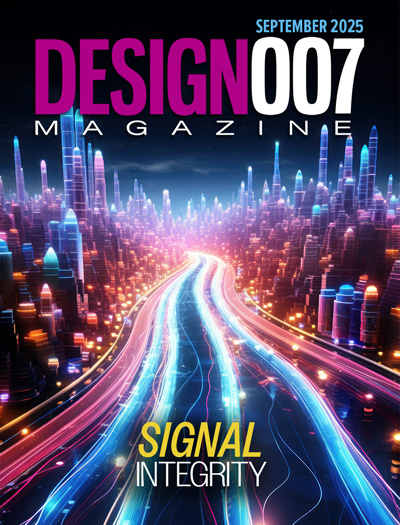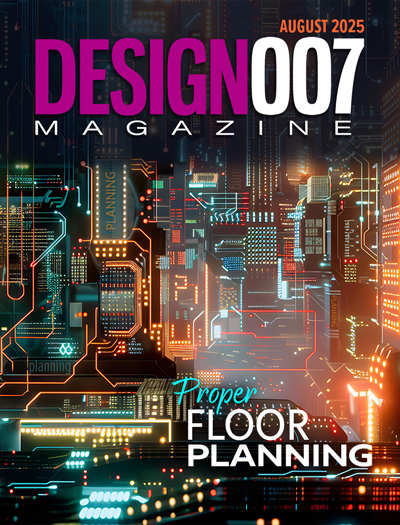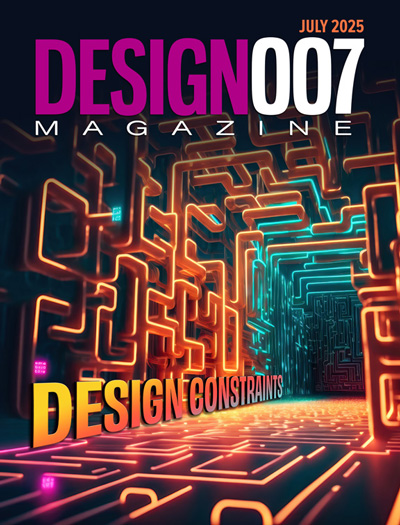-

- News
- Books
Featured Books
- design007 Magazine
Latest Issues
Current Issue
Signal Integrity
If you don’t have signal integrity problems now, you will eventually. This month, our expert contributors share a variety of SI techniques that can help designers avoid ground bounce, crosstalk, parasitic issues, and much more.

Proper Floor Planning
Floor planning decisions can make or break performance, manufacturability, and timelines. This month’s contributors weigh in with their best practices for proper floor planning and specific strategies to get it right.

Showing Some Constraint
A strong design constraint strategy carefully balances a wide range of electrical and manufacturing trade-offs. This month, we explore the key requirements, common challenges, and best practices behind building an effective constraint strategy.
- Articles
- Columns
- Links
- Media kit
||| MENU - design007 Magazine
Zuken Teams With Nano Dimension for 3D Printing Design Flow
November 25, 2017 | Andy Shaughnessy, PCB Design007Estimated reading time: 10 minutes
Mandavia: Printed electronics will be one of many technologies CR-8000 supports, and our goal is to allow engineers to freely design what they want, without the hassle of figuring out what tool can achieve a particular board technology they want to realize. So the types of opportunities we want to present to the market is that if you go with CR-8000 for your full flow, whether it's for production design or for prototyping, you will have one integrated system-level platform, and engineers across disciplines can work and collaborate together. However, we also want to make it non-disruptive to existing design environments, so if you want to augment your current flow with our products to support 3D printing, system co-design, or take advantage of any other unique areas of CR-8000, then you'll have the freedom to do that as well. Our intention is to pursue true enablement for the market.
Shaughnessy: Simon, from your side, this must help you get in more at the design level with the front-end guys.
Fried: Yes, and for us, it's a tremendous opportunity, mainly because it really helps the design community to make that transition, to be able to fully use the technology, which I think otherwise could otherwise have a steeper learning curve. It helps with that education of people to say, "Yes, this is okay, you can do it. You can still be in control. You'll know the boundaries within which you're working."
We're great at printers and materials, and there's a very big community around design and the design software, which is not our focus and collaboration on how best to serve this community is much appreciated.
Mandavia: Again, what made this partnership happen and why this was a great fit for us is not only because we're both developing new technologies for the market space to solve today and tomorrow's problems, but also the way the concepts and the disciplines fit together. For example, you brought up silver versus copper. Well, let's talk about silver and copper on a design. What about silver, copper, and gold?
Not only do you want to prototype it, but down the road you may want to do that for production for various reasons. You want to have the technology and solutions to be able to easily design for multi-material, rules by materials we call it, but also then print it very easily.
Shaughnessy: And you avoid a lot of it by not having to go through the typical assembly profiles and all this heat and everything.
Mandavia: That's exactly it.
Fried: There may be scenarios where there are interim steps where you'll find that manufacturing is perhaps hybrid. You know, you might do a bit of additive and a bit of the subtractive manufacturing. We'll need to have these approaches evaluated, worked through, have the materials be known and their properties known, and under the boundary conditions that you print them in. Traditional copper would continue to play aa key role.
It's one of these areas where it could go in so many directions. It can be a hybrid, it can be a purely additive. At the moment, it's very much a prototyping tool.
Shaughnessy: It seems like it gives you a lot more freedom because you're not having to do all the nastier stuff. They say with printed electronics one-tenth of the machines in a board shop could be used.
Fried: Certainly, you can save a lot of space. We had one site that said exactly that. "Look, we rank a printer like this as equivalent to about 2,000 square feet of space for our internal board prototyping.” So if you're running out of space, it's one option. But I think it's more about if you're running out of time, or if you have more ideas than you have the time to try, and you're missing out on developing stuff you should've explored.
Shaughnessy: And trying isn't as expensive this way, so if you make a mistake…
Fried: Yes, trying is cheaper, and nobody else ever knows about it. Failing fast and saving cheap, and also failing in private. This all encourages innovation.
Shaughnessy: It sounds like this partnership opens up a lot of opportunities.
Mandavia: That's really what we're aiming towards. There are some aspects of what we are aiming for that can be done today, and companies are taking advantage of additive manufacturing now. But I think with what Nano Dimension is offering, along with our partnership, will really open the door to endless possibilities so companies can focus on their innovation.
Also, talking about other advantages of 3D printing, we do not have to deal with hazardous materials as one example. There are many other benefits to this, and that's why we want to advocate this within the industry and drive adoption. If you think about our industry, we don't see too many compelling events, too many big shake ups, especially in printed circuit boards. This is the time that we start thinking about how to aggressively grow our market again, spur new opportunities, and 3D printing is one of those new ideas to support this.
Shaughnessy: You guys are kind of unique in that, because most of the big innovations in printed electronics have been from OEMs themselves. Because they couldn't find anybody to work with and they said, “We'll figure this out. We'll get cardboard and put traces on it or whatever.”
Mandavia: And paper dolls. People are doing all sorts of fun stuff to figure out their problems, but hopefully we can help go through this great new journey for them.
Fried: Doing that to one layer is relatively accessible and easy, and as the layers build up, you need different tools and hardware and software.
Shaughnessy: Well, thanks for speaking with me today.
Mandavia: Good seeing you again, Andy.
Fried: Thank you.
Page 2 of 2
Testimonial
"The I-Connect007 team is outstanding—kind, responsive, and a true marketing partner. Their design team created fresh, eye-catching ads, and their editorial support polished our content to let our brand shine. Thank you all! "
Sweeney Ng - CEE PCBSuggested Items
Closing the Loop on PCB Etching Waste
09/09/2025 | Shawn Stone, IECAs the PCB industry continues its push toward greener, more cost-efficient operations, Sigma Engineering’s Mecer System offers a comprehensive solution to two of the industry’s most persistent pain points: etchant consumption and rinse water waste. Designed as a modular, fully automated platform, the Mecer System regenerates spent copper etchants—both alkaline and acidic—and simultaneously recycles rinse water, transforming a traditionally linear chemical process into a closed-loop system.
Driving Innovation: Depth Routing Processes—Achieving Unparalleled Precision in Complex PCBs
09/08/2025 | Kurt Palmer -- Column: Driving InnovationIn PCB manufacturing, the demand for increasingly complex and miniaturized designs continually pushes the boundaries of traditional fabrication methods, including depth routing. Success in these applications demands not only on robust machinery but also sophisticated control functions. PCB manufacturers rely on advanced machine features and process methodologies to meet their precise depth routing goals. Here, I’ll explore some crucial functions that empower manufacturers to master complex depth routing challenges.
Trouble in Your Tank: Minimizing Small-via Defects for High-reliability PCBs
08/27/2025 | Michael Carano -- Column: Trouble in Your TankTo quote the comedian Stephen Wright, “If at first you don’t succeed, then skydiving is not for you.” That can be the battle cry when you find that only small-diameter vias are exhibiting voids. Why are small holes more prone to voids than larger vias when processed through electroless copper? There are several reasons.
The Government Circuit: Navigating New Trade Headwinds and New Partnerships
08/25/2025 | Chris Mitchell -- Column: The Government CircuitAs global trade winds continue to howl, the electronics manufacturing industry finds itself at a critical juncture. After months of warnings, the U.S. Government has implemented a broad array of tariff increases, with fresh duties hitting copper-based products, semiconductors, and imports from many nations. On the positive side, tentative trade agreements with Europe, China, Japan, and other nations are providing at least some clarity and counterbalance.
How Good Design Enables Sustainable PCBs
08/21/2025 | Gerry Partida, Summit InterconnectSustainability has become a key focus for PCB companies seeking to reduce waste, conserve energy, and optimize resources. While many discussions on sustainability center around materials or energy-efficient processes, PCB design is an often overlooked factor that lies at the heart of manufacturing. Good design practices, especially those based on established IPC standards, play a central role in enabling sustainable PCB production. By ensuring designs are manufacturable and reliable, engineers can significantly reduce the environmental impact of their products.


